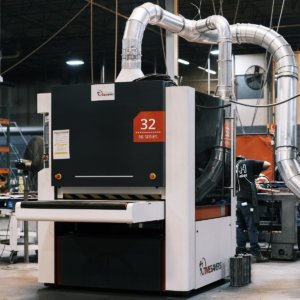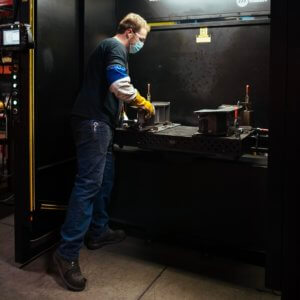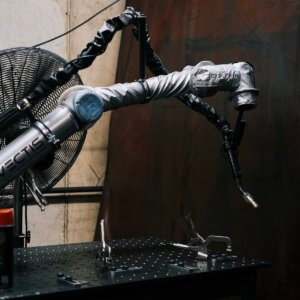Continuous Improvement: A Key Element of Success
March 14, 2022
Here at Laser Precision, we have always believed in taking measures that help us to work smarter and faster. This concept is more important than ever in today’s operating environment. Supply chain issues and the skilled worker shortage are not going away anytime soon. Shops that don’t take action may find themselves left behind.
Our team is outstanding, and they’ve been great about working overtime to keep up with the increasing demand for our services. However, demand continues to rise. The judicious use of automation and purchase of additional equipment will help us increase productivity, maintain our on-time record and bring better work/life balance to our workforce.
In this article, we will provide examples of what continuous improvement looks like in three of our departments.
Department 1: Deburr/Oxide Removal
Previously, we used to knock parts out of the sheets coming off the laser cutter, sort them, palletize them and place them on deburr racks until it was time to pull them out to process them by hand. We had a 15-year-old deburring machine, but it had a lot of mechanical issues and was costly to maintain. The entire procedure was slow and labor-intensive.
We shrunk the processing window by purchasing two Timesaver 32 RB (rotary brush) machines. Now, when the parts are knocked out, they immediately go thru the Timesaver oxide removal machine and then to a deburr table. Within an hour of the cut, we’ve taken a sheet of steel and done all the things we would traditionally do to it, but a lot faster.

By speeding up and streamlining the process, we increased the efficiency of our deburr department to the point where we have been able to assign our human resources there to different tasks, which helps alleviate the constraints of labor we’ve had in the past 18 months.
For additional time savings, we document all the settings that we create for all the different thicknesses of material and standardize them. The new process will then be documented for our ISO 9001:2015 compliance.
Department 2: Machining
Our CNC department was using an old lathe and several aging vertical machining centers. A lot of time was required just tending them, taking parts out, closing the door, etc. One of the philosophies we’re trying to drive is to keep the spindles running. We use the time saved to develop the operators tending the machines so they can start to think more like machinists instead of just “minders.”
We started the makeover with new equipment. The Haas DM-1 is a compact, high-speed machining center. We bought it outfitted with a Midaco pallet changer, thru-spindle coolant and tooling package. The pallet changer is a big step forward because it allows the operator to be loading and unloading parts off one pallet while the other pallet is in the spindle zone being machined. The productivity of this machine is outstanding, and we already have our eyes on another one.

The other machine we purchased for our CNC department is a Haas ST-20Y lathe. We had a lathe, but everything about it was manual. The new model has live tooling and is outfitted with a barfeeder. Instead of having our saw department cut down every blank, we can order a 20’ bar and cut it down to 42” lengths, then and throw it in the barfeeder for continuous machining. The new lathe also has an automatic parts catcher. After it machines the part, the built-in y-axis cuts the part off, and it falls into the parts catcher.
A big advantage with this arrangement is there’s no need to tend the machine full-time. You can set it up and wait for a stack of parts to accumulate in the parts catcher. This increases productivity and frees up time for operators to do other tasks. In addition, the new lathe will also open opportunities for us to take on more traditional lathe work. We currently only do add-on machining to bent welded pieces, but this machine will allow us to expand into producing complex parts like shafts, gears and more.
Department 3: Welding
Finding new certified welders to work in our shop is problematic at best. We can’t lower our standards and refuse to jeopardize our performance.
To meet our goals, we knew that automation was the way to go. We saw no hesitation from our welders in bringing it in. They realize the technology is a complementary asset and not a replacement asset. As a business, automation gives us more capacity and redundancy. Everyone benefits. To date, we have installed three Vectis Cobot Systems and a PA350S Miller Robotic Welder Cell.

The PA350S provides a full spectrum of welding processes and is designed for the demands of industrial welding operations. It features an extremely fast AC servo capable of rotating the turntable 180 degrees. Introducing this automated welder should drastically improve times on certain weld requirements. The operator can load four or five parts into the cell, walk away and tack weld the next batch and get it ready for loading.
The cobots are great because it takes less time to program them. We have parts that, from a design and quantity perspective, make sense to put on the Miller because it’s faster, but having the cobot systems give us the ability to address low mix-high volume work and high mix-low volume work any time of the day. The system is portable and versatile. We just move the unit to where the work is.
Continuous Improvement in Every Department
As the market remains in flux, we will continue to improve our equipment and processes. We would do so even without those constraints, because it’s just a good business practice. If you have a fabrication project and aren’t getting the service and quality you deserve, please contact us. We’d love to work with you.

